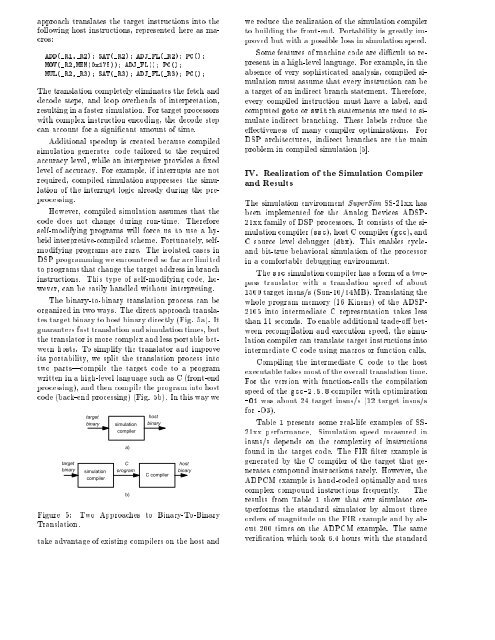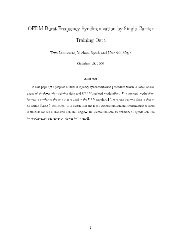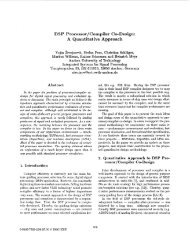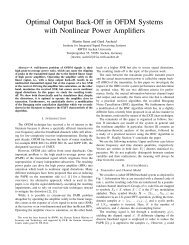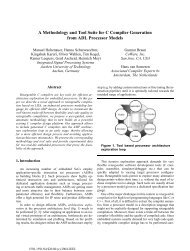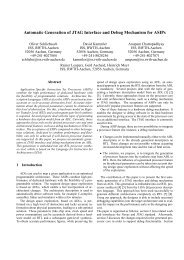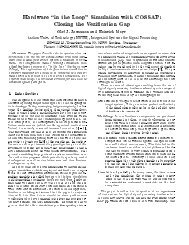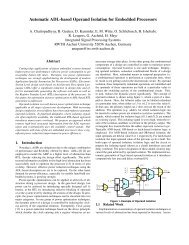supersim | a new technique for simulation of programmable ... - ICE
supersim | a new technique for simulation of programmable ... - ICE
supersim | a new technique for simulation of programmable ... - ICE
You also want an ePaper? Increase the reach of your titles
YUMPU automatically turns print PDFs into web optimized ePapers that Google loves.
approach translates the target instructions into the<br />
following host instructions, represented here as macros:<br />
ADD(_R1,_R2) SAT(_R2) ADJ_FL(_R2) PC()<br />
MOV(_R2,MEM(0x175)) ADJ_FL() PC()<br />
MUL(_R2,_R3) SAT(_R3) ADJ_FL(_R3) PC()<br />
The translation completely eliminates the fetch and<br />
decode steps, and loop overheads <strong>of</strong> interpretation,<br />
resulting in a faster <strong>simulation</strong>. For target processors<br />
with complex instruction encoding, the decode step<br />
can account <strong>for</strong> a signicant amount<strong>of</strong>time.<br />
Additional speedup is created because compiled<br />
<strong>simulation</strong> generates code tailored to the required<br />
accuracy level, while an interpreter provides a xed<br />
level <strong>of</strong> accuracy. For example, if interrupts are not<br />
required, compiled <strong>simulation</strong> suppresses the <strong>simulation</strong><br />
<strong>of</strong> the interrupt logic already during the preprocessing.<br />
However, compiled <strong>simulation</strong> assumes that the<br />
code does not change during run-time. There<strong>for</strong>e<br />
self-modifying programs will <strong>for</strong>ce us to use a hybrid<br />
interpretive-compiled scheme. Fortunately, selfmodifying<br />
programs are rare. The isolated cases in<br />
DSP programming we encountered so far are limited<br />
to programs that change the target address in branch<br />
instructions. This type <strong>of</strong> self-modifying code, however,<br />
can be easily handled without interpreting.<br />
The binary-to-binary translation process can be<br />
organized in two ways. The direct approach translates<br />
target binary to host binary directly (Fig. 5a). It<br />
guarantees fast translation and <strong>simulation</strong> times, but<br />
the translator is more complex and less portable between<br />
hosts. To simplify the translator and improve<br />
its portability, we split the translation process into<br />
two parts|compile the target code to a program<br />
written in a high-level language such as C (front-end<br />
processing), and then compile the program into host<br />
code (back-end processing) (Fig. 5b). In this waywe<br />
target<br />
binary<br />
target<br />
binary<br />
<strong>simulation</strong><br />
compiler<br />
<strong>simulation</strong><br />
compiler<br />
a)<br />
C<br />
program<br />
b)<br />
host<br />
binary<br />
C compiler<br />
host<br />
binary<br />
Figure 5: Two Approaches to Binary-To-Binary<br />
Translation.<br />
take advantage <strong>of</strong> existing compilers on the host and<br />
we reduce the realization <strong>of</strong> the <strong>simulation</strong> compiler<br />
to building the front-end. Portability is greatly improved<br />
but with a possible loss in <strong>simulation</strong> speed.<br />
Some features <strong>of</strong> machine code are dicult to represent<br />
in a high-level language. For example, in the<br />
absence <strong>of</strong> very sophisticated analysis, compiled <strong>simulation</strong><br />
must assume that every instruction can be<br />
a target <strong>of</strong> an indirect branch statement. There<strong>for</strong>e,<br />
every compiled instruction must have a label, and<br />
computed goto or switch statements are used to simulate<br />
indirect branching. These labels reduce the<br />
eectiveness <strong>of</strong> many compiler optimizations. For<br />
DSP architectures, indirect branches are the main<br />
problem in compiled <strong>simulation</strong> [5].<br />
IV. Realization <strong>of</strong> the Simulation Compiler<br />
and Results<br />
The <strong>simulation</strong> environment SuperSim SS-21xx has<br />
been implemented <strong>for</strong> the Analog Devices ADSP-<br />
21xx family <strong>of</strong> DSP processors. It consists <strong>of</strong> the <strong>simulation</strong><br />
compiler (ssc), host C compiler (gcc), and<br />
C source level debugger (dbx). This enables cycleand<br />
bit-true behavioral <strong>simulation</strong> <strong>of</strong> the processor<br />
in a com<strong>for</strong>table debugging environment.<br />
The ssc <strong>simulation</strong> compiler has a <strong>for</strong>m <strong>of</strong> a twopass<br />
translator with a translation speed <strong>of</strong> about<br />
1500 target insns/s (Sun-10/64MB). Translating the<br />
whole program memory (16 Kinsns) <strong>of</strong> the ADSP-<br />
2105 into intermediate C representation takes less<br />
than 11 seconds. To enable additional trade-o between<br />
recompilation and execution speed, the <strong>simulation</strong><br />
compiler can translate target instructions into<br />
intermediate C code using macros or function calls.<br />
Compiling the intermediate C code to the host<br />
executable takes most <strong>of</strong> the overall translation time.<br />
For the version with function-calls the compilation<br />
speed <strong>of</strong> the gcc-2.5.8 compiler with optimization<br />
-O1 was about 24 target insns/s (12 target insns/s<br />
<strong>for</strong> -O3).<br />
Table 1 presents some real-life examples <strong>of</strong> SS-<br />
21xx per<strong>for</strong>mance. Simulation speed measured in<br />
insns/s depends on the complexity <strong>of</strong> instructions<br />
found in the target code. The FIR lter example is<br />
generated by the C compiler <strong>of</strong> the target that generates<br />
compound instructions rarely. However, the<br />
ADPCM example is hand-coded optimally and uses<br />
complex compound instructions frequently. The<br />
results from Table 1 show that our simulator outper<strong>for</strong>ms<br />
the standard simulator by almost three<br />
orders <strong>of</strong> magnitude on the FIR example and by about<br />
200 times on the ADPCM example. The same<br />
verication which took 6.4 hours with the standard


